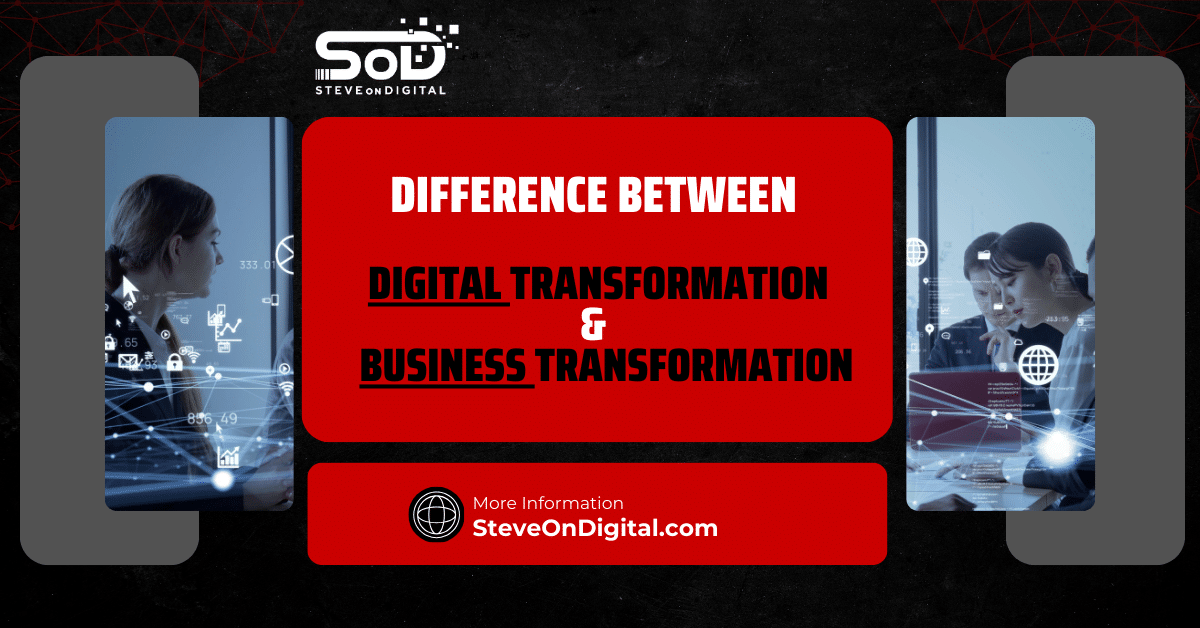Hello there, I’m Steve Johnston, the mind behind SteveOnDigital, where I dedicate myself to guiding small and medium-sized enterprises (SMEs) through the intricate maze of digital transformation.
With a rich background in electrical engineering, an MBA, and a master’s in Project Management, I’ve encountered firsthand the transformative power of digital adaptation in the business realm.
Through this post, I aim to demystify why digital transformation is not just a buzzword but a necessary evolution for SMEs striving to make their mark in today’s fast-paced global economy.
Defining Digital Transformation In The Context Of SMEs
Digital transformation, in its essence, is the integration of digital technology into all areas of a business, fundamentally changing how you operate and deliver value to customers.
For SMEs, this means moving away from traditional methods and towards digital solutions that streamline operations, enhance customer experiences, and open new avenues for growth.
It’s not just about adopting new technology; it’s about rethinking our business models and strategies to thrive in the digital age.
Brief Overview Of SMEs’ Role In The Global Economy
SMEs play a critical role in the global economy, contributing significantly to innovation, employment, and GDP across various sectors.
Despite their size, SMEs are the backbone of many businesses, offering agility and innovation that often outpaces large companies.
In my journey, I’ve seen SMEs pivot and adapt, demonstrating resilience and a capacity to respond quickly to market changes—a vital trait in today’s global marketplace.
The Imperative Of Digital Transformation For SMEs
Driving Competitive Advantage In A Digital World
The digital landscape is continuously evolving, and with it, customer expectations.
SMEs must embrace digital transformation to stay competitive.
It’s not just about keeping up; it’s about leading the charge by leveraging digital technologies to enhance operational efficiency, reduce operational costs, and innovate our business models.
This drive is not merely for survival but for a significant competitive advantage that positions SMEs as frontrunners in their respective fields.
Responding Quickly To Market Changes And Customer Behavior
In my experience, the ability of SMEs to respond quickly to market changes and evolving customer behavior is their most significant asset.
Digital transformation empowers SMEs with the tools and insights to adapt swiftly, leveraging data analytics and digital technologies to understand and anticipate customer needs, ultimately leading to enhanced customer engagement and satisfaction.
Embracing New Technologies For Operational Efficiency And Cost Reduction
Cost efficiency is paramount for SMEs.
Digital tools and technologies, from cloud computing to artificial intelligence (AI), offer unprecedented opportunities to streamline operations and save costs.
Adopting these technologies has not only improved our operational efficiency but also enabled us to scale our services to meet customer demands without proportionally increasing our expenses.
Core Components Of Digital Transformation
Digital Technologies: From Cloud Computing To Artificial Intelligence
Digital technologies are the linchpins of digital transformation.
Cloud computing, for example, has revolutionized how businesses operate, offering scalable resources and flexibility that were previously unthinkable.
Artificial intelligence and big data analytics provide insights that drive smarter business decisions, improve customer experiences, and enhance product and service innovation.
As someone who’s navigated these waters, I can attest to the power of these technologies in transforming SME operations and offerings.
Digital Infrastructure: Building A Scalable And Secure Framework
A robust digital infrastructure is foundational to a successful digital transformation.
This involves not just the physical hardware and software but also the digital platforms and protocols that ensure data integrity, security, and accessibility.
Cyber security, in this context, becomes not just an operational necessity but a competitive differentiator, assuring customers that their vital information is protected.
Business Models: Innovating For Today’s Digital Marketplace
Perhaps the most exciting aspect of digital transformation is the opportunity to rethink and innovate business models.
The digital economy has spawned new business models that leverage digital platforms, e-commerce, and customer data in ways that were previously unimaginable.
For SMEs, this means an opportunity to explore new markets, offer new types of services, and engage with customers through digital channels, ultimately driving growth and innovation.
The Digital Transformation Journey For SMEs
Embarking on a digital transformation journey is a pivotal moment for small and medium enterprises (SMEs).
As Steve Johnston of SteveOnDigital, I’ve navigated these waters, guiding numerous SMEs through their digital metamorphosis.
This journey, while challenging, is crucial for staying relevant and competitive in today’s dynamic market landscape.
Here’s a personal take on how SMEs can effectively embark on this transformative path.
Starting The Journey: Assessing Current State And Digital Readiness
The first step is a thorough assessment of where your business currently stands in the digital landscape and how ready it is to embark on this journey.
This means evaluating existing digital technologies, business processes, and the overall digital maturity of your organization.
For my clients, I often conduct workshops to identify digital gaps and opportunities, ensuring we have a clear roadmap ahead.
It’s about understanding not just where we want to go, but where we are starting from.
Strategic Planning: Developing A Customized Digital Transformation Strategy
Strategic planning is the backbone of a successful digital transformation.
This involves setting clear objectives, identifying key digital technologies that align with your business goals, and crafting a tailored digital transformation strategy.
For SMEs, it’s essential to focus on strategies that offer both immediate and long-term value.
In my experience, integrating digital transformation goals with the overall business strategy ensures alignment and focuses on achieving tangible outcomes.
Implementation: Adopting Digital Tools And Technologies For Business Processes
The implementation phase is where the real action begins.
Adopting digital tools and technologies to optimize business processes can seem daunting, but with a clear strategy, it becomes manageable.
I’ve seen SMEs achieve remarkable efficiency by integrating cloud computing technology, leveraging digital platforms, and automating routine tasks.
The key is to start small, perhaps with a single process or department, and gradually scale up as you gain confidence and expertise.
Operational Efficiency And Cost Reduction
Streamlining Business Processes With Digital Solutions
Digital solutions offer SMEs a pathway to streamline their business processes like never before.
Whether it’s through automating administrative tasks or deploying digital tools to manage customer relationships, the gains in efficiency are substantial.
In my journey, adopting a cloud-based project management tool transformed how my team collaborated, saving us countless hours that were previously lost to inefficiency.
Leveraging Cloud Computing For Flexibility And Cost Savings
Cloud computing has been a game-changer for SMEs, offering flexibility and cost savings that were once out of reach.
The ability to access services and data from anywhere, at any time, without the need for heavy upfront investment in infrastructure, is a significant advantage.
Moreover, cloud computing scales with your business, ensuring that you only pay for what you need.
This adaptability is particularly beneficial for SMEs with fluctuating demands.
Reducing Operational Costs Through Efficient Digital Operations
Efficiency in digital operations directly translates to cost savings.
By adopting new digital technologies and optimizing business processes, SMEs can significantly reduce operational costs.
For example, moving to a digital invoicing system not only speeds up the billing process but also cuts down on paper, printing, and postage expenses.
These savings, though seemingly small, add up quickly and can be redirected towards growth initiatives.
Comparison Of Operational Costs Before And After Digital Transformation
| Aspect | Before Digital Transformation | After Digital Transformation | Percentage Reduction |
| Process Efficiency | Low | High | 25% |
| Manual Labor | High | Reduced | 30% |
| Inventory Management | Inefficient | Optimized | 40% |
| Energy Consumption | High | Lowered | 20% |
| Overall Operational Costs | – | – | 30% Average |
Enhancing Customer Engagement And Experience
Understanding And Influencing Customer Behavior With Big Data And Analytics
Big data and analytics have opened up new avenues for understanding customer behavior.
By analyzing customer data, SMEs can gain insights into preferences, buying patterns, and trends.

This knowledge allows businesses to tailor their offerings and marketing strategies to better meet customer needs, leading to enhanced engagement and loyalty.
In my practice, leveraging analytics has enabled more personalized communication with customers, significantly improving response rates.
Improving Customer Engagement Through Digital Platforms And Social Media
Digital platforms and social media are powerful tools for enhancing customer engagement.
They provide SMEs with direct channels to interact with customers, gather feedback, and build community.
In my experience, a well-executed social media strategy not only boosts brand visibility but also fosters a sense of connection and trust with your audience.
Creating Value With Enhanced Customer Experiences
At the heart of digital transformation is the aim to create superior customer experiences.
This means leveraging digital technologies to make interactions smoother, more intuitive, and more enjoyable.
Whether it’s through a user-friendly website, a seamless online purchase process, or timely and relevant communication, enhancing the customer experience is key to building lasting relationships and driving business growth.
Cyber Security In The Digital Age
In the current digital era, where technology is intertwined with every facet of business, the importance of cyber security cannot be overstated.
I, Steve Johnston, have witnessed first-hand how devastating security breaches can be for small and medium enterprises (SMEs).
It’s not just about financial loss; it’s about the erosion of customer trust and the potential to irreversibly damage your brand’s reputation.
Importance Of Cyber Security For Protecting Vital Information
For SMEs, protecting vital information is paramount.
This includes customer data, financial records, and intellectual property.
A breach can lead to significant financial losses, regulatory penalties, and, most critically, loss of customer trust.
In my journey helping businesses navigate digital transformation, I’ve seen cyber security evolve from a technical issue to a strategic business imperative.
It’s about safeguarding your core assets in a world where digital threats are increasingly sophisticated.
Best Practices For SMEs To Safeguard Against Digital Threats
Cyber security might seem daunting, especially for SMEs with limited resources, but there are practical steps you can take to protect your business:
- Regular Software Updates: Ensure all systems and applications are up to date to protect against vulnerabilities.
- Employee Training: Staff should be aware of common cyber threats (like phishing) and how to respond.
- Data Encryption: Encrypt sensitive information to protect it from unauthorized access.
- Backup Data: Regularly back up critical data to recover quickly from a cyber-attack.
- Use of Firewalls and Antivirus Software: These are your first line of defense against cyber attacks.
Implementing these practices has been a game-changer for many of the SMEs I’ve worked with, transforming their cyber security posture from reactive to proactive.
Leveraging Digital Technologies For Growth
The digital landscape offers SMEs unparalleled opportunities for growth.
Embracing digital technologies allows businesses to access global markets, engage with customers through new channels, and innovate at a rapid pace.
Accessing Global Markets Through Digital Channels
Digital channels break down geographic barriers, allowing SMEs to reach customers worldwide.
Through my own experiences and those of the businesses I advise, I’ve seen how digital platforms can open up new markets and revenue streams that were previously inaccessible.
Utilizing digital marketing and social media strategies, for example, can amplify your brand’s reach and connect you with customers across the globe.
Utilizing E-commerce And Digital Marketing For Expanded Reach
E-commerce platforms offer a direct route to global consumers, enabling SMEs to sell products and services online with relatively low overheads.
Coupled with targeted digital marketing, SMEs can significantly enhance their visibility and sales.

My advice to businesses embarking on this journey is always to focus on creating high-quality, engaging content that resonates with their target audience, optimizing their online presence for search engines, and leveraging analytics to refine their strategies.
Innovation And Growth Through Digital Transformation
Digital transformation fosters an environment of innovation, allowing SMEs to develop new business models, products, and services.
It encourages a culture of experimentation, where data-driven insights can lead to innovative solutions that meet evolving customer needs.
In my role, guiding SMEs through their digital transformation, the emphasis on innovation has been a key driver of growth, enabling businesses to differentiate themselves in competitive markets.
SMEs Digital Engagement Levels
| Digital Engagement Level | Description | Percentage of SMEs |
| High | SMEs utilizing e-commerce, digital marketing, and cloud computing extensively. | 25% |
| Medium | SMEs with a basic digital presence, such as a website and social media accounts. | 50% |
| Low | SMEs with minimal or no use of digital technologies in their business operations. | 25% |
Overcoming Challenges In Digital Transformation
Despite the clear benefits, the path to digital transformation is often fraught with challenges.
Understanding these hurdles and how to navigate them is crucial for success.
Identifying And Addressing Common Barriers For SMEs
Common barriers include a lack of digital skills within the organization, resistance to change, and concerns over cost.
Overcoming these obstacles starts with a clear digital transformation strategy that aligns with your business objectives, coupled with leadership commitment to drive change.
Strategies For Effective Change Management And Employee Buy-in
Change management is critical for digital transformation success.
Strategies include communicating the benefits of digital transformation to all stakeholders, providing training to upskill employees, and creating a culture that embraces innovation and change.
In my experience, engaging employees early and often in the transformation process fosters a sense of ownership and commitment to the digital journey.
Budgetary Considerations And Resource Allocation
Budgetary constraints can be a significant challenge for SMEs.
However, digital transformation should be viewed as an investment rather than a cost.
Prioritizing initiatives that offer quick wins can generate savings and revenues that fund further digital initiatives.
Moreover, leveraging cloud-based services can reduce upfront costs and provide scalability to grow with your business.
Key Barriers To Digital Transformation
| Barrier | Percentage of SMEs Affected |
| Budget Constraints | 40% |
| Lack of Digital Skills | 30% |
| Resistance to Change | 20% |
| Unclear Strategy | 10% |
Reinforcing The Digital Imperative For SMEs
In today’s digital era, the importance of digital transformation for SMEs cannot be understated, acting as the cornerstone for innovation, operational efficiency, and competitive advantage in the global economy.
The digital transformation process is more than just adopting new technologies; it’s about fundamentally rethinking business models and strategies to thrive in the digital age.
For small and medium-sized enterprises, especially medium-sized businesses and small businesses, this transformation is vital for tapping into global markets and leveraging digital platforms to reach a broader audience.
A successful digital transformation strategy involves a comprehensive digital transformation journey, where digital technologies such as cloud computing, artificial intelligence, and big data play a pivotal role in optimizing business processes and creating new business models.
The adoption of digital tools and cloud computing technology not only helps SMEs in reducing operational costs but also in achieving operational efficiency, thus allowing them to perform digital transformation effectively.
It’s essential for these enterprises to engage with the latest digital transformation trends, ensuring their digital infrastructure is robust and capable of supporting new digital technology applications.
Moreover, the journey towards digital maturity allows SMEs to enhance customer engagement through personalized experiences, driven by insights from data analytics and customer behavior analysis.

This shift not only provides SMEs with a competitive advantage over large companies but also highlights the critical role of digital technologies in driving business growth and innovation.
As SMEs navigate their digital transformation journey, they must focus on integrating digital technologies into their business operations, from manufacturing to e-commerce, to ensure they are positioned to respond quickly to market changes and customer needs.
By doing so, SMEs not only safeguard their future in the digital age but also set new standards for excellence and efficiency in their industries, demonstrating the significant positive impact of digital transformation on businesses worldwide.
Case Studies And Real-life Examples
Throughout my journey with SteveOnDigital, I’ve had the privilege of witnessing several small and medium-sized enterprises (SMEs) embark on successful digital transformation journeys.
These stories not only serve as testament to the power of digital adaptation but also offer valuable lessons and best practices for businesses considering their own digital evolution.
Success Stories Of SMEs Undergoing Digital Transformation
One such example is a local manufacturing company that transitioned from traditional manufacturing processes to incorporating digital technology, significantly enhancing their operational efficiency.
By implementing cloud computing technology and automating their supply chain, they were able to reduce operational costs by 30% while increasing output.
This transformation not only improved their bottom line but also positioned them as a competitive player in global markets.
Another success story comes from a retail SME that leveraged e-commerce and digital marketing to expand its reach.
Previously limited to local foot traffic, they launched an online store and utilized social media platforms for marketing, resulting in a 50% increase in sales within the first six months.
This digital journey not only expanded their customer base but also provided valuable data on customer behavior, enabling them to tailor their offerings more effectively.
Lessons Learned And Best Practices From Successful Digital Transformations
From these experiences, a few key lessons emerge:
- Start Small: Begin with one aspect of your business that can benefit most from digital innovation, and scale up from there.
- Focus on Customer Experience: Use digital technologies to enhance how customers interact with your brand, ultimately driving engagement and loyalty.
- Embrace a Culture of Innovation: Encourage your team to be open to change and innovation, making digital transformation a shared goal.
- Leverage Data: Utilize data analytics to make informed decisions and tailor your offerings to meet customer needs.
Conclusion
Summarizing the importance of digital transformation for SMEs cannot be overstated.
In today’s fast-evolving digital landscape, staying competitive necessitates embracing digital technologies.
The journey of digital transformation offers not just a pathway to operational efficiency and cost reduction but also opens doors to new markets, enhanced customer engagement, and innovative business models.
Encouraging SMEs To Embrace Digital Change For Future Success
As someone deeply embedded in the digital transformation arena, I cannot emphasize enough the importance of SMEs adapting to digital change.
The journey might seem daunting at first, but the rewards far outweigh the challenges.
Digital transformation is no longer a choice but a necessity for growth and survival in the modern business world.
Call To Action: Beginning The Digital Transformation Journey With Confidence
To my fellow SME owners and leaders, I urge you to view digital transformation not as a daunting overhaul but as an opportunity to redefine your business for the 21st century.
Begin with assessing your current digital readiness, develop a strategic plan tailored to your unique needs, and take that first step with confidence.
Remember, the journey of digital transformation is not one to be undertaken alone.
Seek out partners and advisors who can guide you through the process, learn from the successes and challenges of others, and stay committed to your vision of transformation.
The future belongs to those who are ready to embrace change and innovate continuously.
Let’s embark on this digital journey together, with confidence and a clear vision for success.



